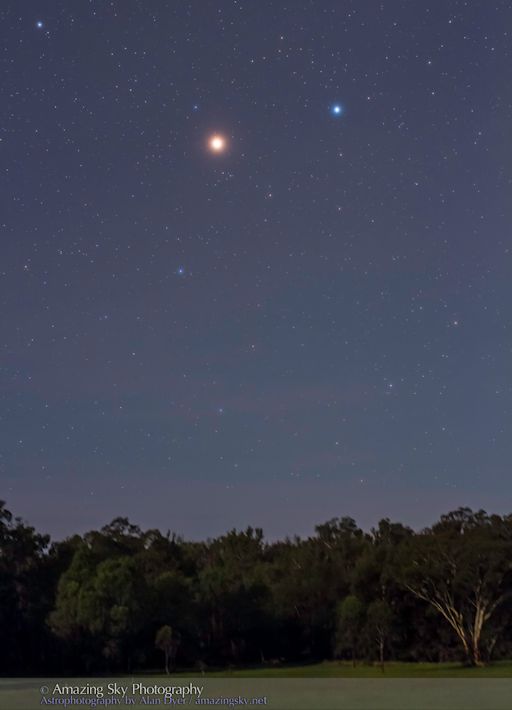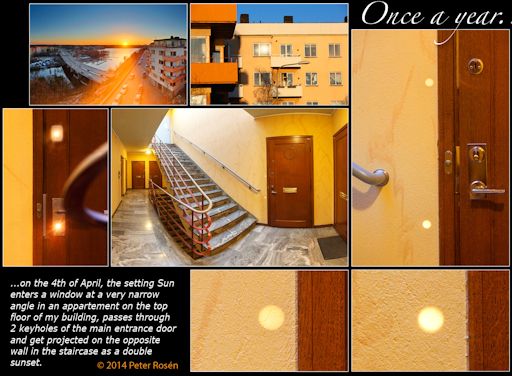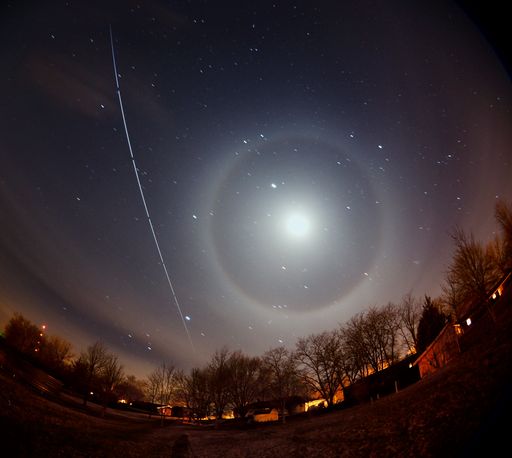On April 15th there will be a total eclipse of the Moon. Got clouds? No problem. The event will be broadcast live on the web by the Coca-Cola Science Center. | | |
QUIET SUN: With no sunspots actively flaring, solar activity is low. NOAA forecasters put the odds of an X-flare today at no more than 1%. Solar flare alerts: text, voice
CLOSE ENCOUNTER WITH MARS: This is a good week to see the planet Mars. On April 8th, Mars will be "at opposition"--that is, perfectly opposite the sun in the midnight sky. And then, on April 14th, Mars makes its closest approach to Earth since 2012. Look for the Red Planet rising in the east at sunset, shining brighter than a 1st-magntitude star. Alan Dyer sends this picture of the Red Planet from Coonabarabran, NSW, Australia:

"The reddish tint of Mars contrasts nicely with blue-white Spica, the brightest star in Virgo," says Dyer. "If the arrangement of Mars and Spica looks unusual, it's because I took this from Australia. So the relative position of Mars and Spica looks upside down compared to a northern hemisphere view. The gum trees in the foreground are illuminated by the waxing Moon."
To learn more about the close encounter, watch the video "Opposition of Mars" from Science@NASA.
Realtime Mars Photo Gallery
MINI-STONEHENGE DISCOVERED IN STOCKHOLM: "A year ago, I was standing in the staircase on the top floor of my apartment building talking to a neighbor," recalls Peter Rosén of Stockholm, Sweden. "Suddenly he noticed a perfect image of the Sun slowly moving across the wall behind me. The Sun was shining through a keyhole which acted as a lens, just like a gigantic pinhole camera. It only lasted for a couple of minutes."
Rosén is a photographer, and he wanted to record the phenomenon. "Unfortunately I had not taken note of the exact date and time. So, this spring, I have been waiting for days with my camera ready on a tripod." Finally, on April 4th, the alignment occurred:

"When the Sun finally appeared on the 4th of April, there was not one but two perfect tiny Suns, slowly moving across the opposite wall," says Rosén. "Our building is perfectly oriented to the cardinal points so theoretically it could have occured on the spring equinox, but as the windows are slightly offset, we have to wait for 2 more weeks before getting this perfect alignment."
"But it still is like having a miniature Stonehenge at home!"
Extra: Reader Tom O'Brian offers an additional perspective on the 'Stockholm Stonehenge': "A better comparison might be that of Newgrange in Ireland, where the Neolithic tomb entrance perfectly aligns with the moment of sunrise at the winter solstice each year. Newgrange is older than the pyramids and than Stonehenge. Because of the variability of Irish weather, sunlight floods the tomb on only about one year in five. So its builders, all those thousands of years ago, would on average have needed to wait five years between alignments even at the building stage of their monument and thereafter to observe the solstice."
Realtime Space Weather Photo Gallery
SPACE STATION SIGHTINGS: This week, the International Space Station is making a series of bright passes over towns and cities in North America. On April 5th in Albany, Missouri, Dan Bush witnessed an ISS-lunar conjunction:

"The moon was surrounded by a beautiful ice halo when the space station passed by," says Bush. "This is a composite of eight 20-second exposures."
Soon, the streak the ISS makes when it passes overhead will double. On Monday, April 14th, SpaceX will launch a Dragon spacecraft to rendezvous with the space station. Filled with almost 5,000 pounds of scientific experiments and supplies, the Dragon will dock with the ISS two days later on April 16th. Prior to docking, sky watchers might be able to see the two spacecraft, ISS and Dragon, moving in tandem through the night sky.
Dragon will remain attached to the space station's Harmony module until mid-May and splash down in the Pacific Ocean off the coast of Baja California with more than 3,000 pounds of experiment samples and equipment returning from the station.
To find out when the ISS and, soon, the Dragon will fly over your hometown, check Spaceweather.com's Simple Satellte Tracker.
Realtime Comet Photo Gallery
Realtime Aurora Photo Gallery
Every night, a network of NASA all-sky cameras scans the skies above the United States for meteoritic fireballs. Automated software maintained by NASA's Meteoroid Environment Office calculates their orbits, velocity, penetration depth in Earth's atmosphere and many other characteristics. Daily results are presented here on Spaceweather.com.
On Apr. 5, 2014, the network reported 3 fireballs.
(3 sporadics)

In this diagram of the inner solar system, all of the fireball orbits intersect at a single point--Earth. The orbits are color-coded by velocity, from slow (red) to fast (blue). [Larger image] [movies]
Potentially Hazardous Asteroids (
PHAs) are space rocks larger than approximately 100m that can come closer to Earth than 0.05 AU. None of the known PHAs is on a collision course with our planet, although astronomers are finding
new ones all the time.
On April 7, 2014 there were 1464 potentially hazardous asteroids.
Notes: LD means "Lunar Distance." 1 LD = 384,401 km, the distance between Earth and the Moon. 1 LD also equals 0.00256 AU. MAG is the visual magnitude of the asteroid on the date of closest approach. | | The official U.S. government space weather bureau |
| | The first place to look for information about sundogs, pillars, rainbows and related phenomena. |
| | Researchers call it a "Hubble for the sun." SDO is the most advanced solar observatory ever. |
| | 3D views of the sun from NASA's Solar and Terrestrial Relations Observatory |
| | Realtime and archival images of the Sun from SOHO. |
| | from the NOAA Space Environment Center |
| | the underlying science of space weather |

